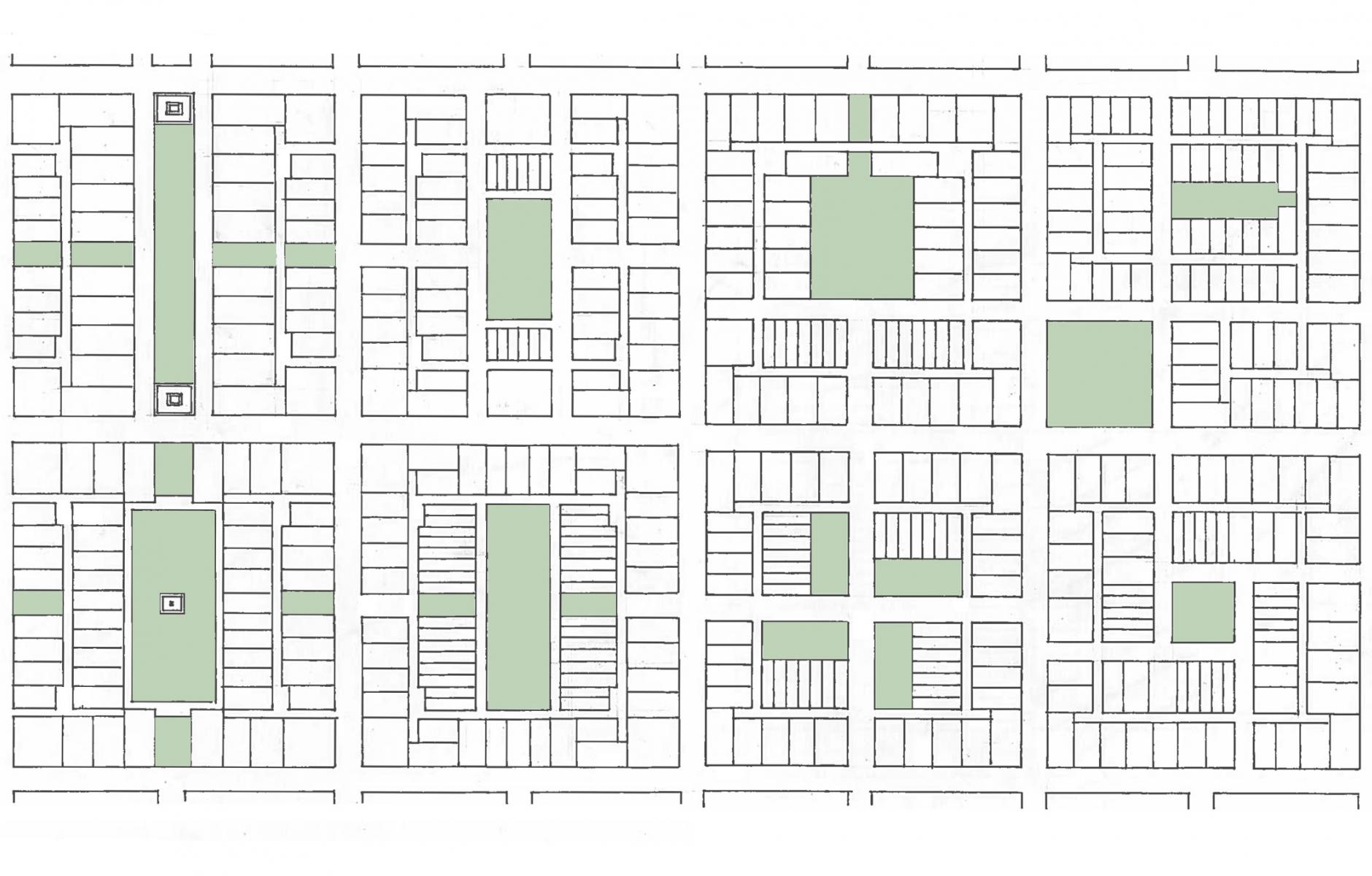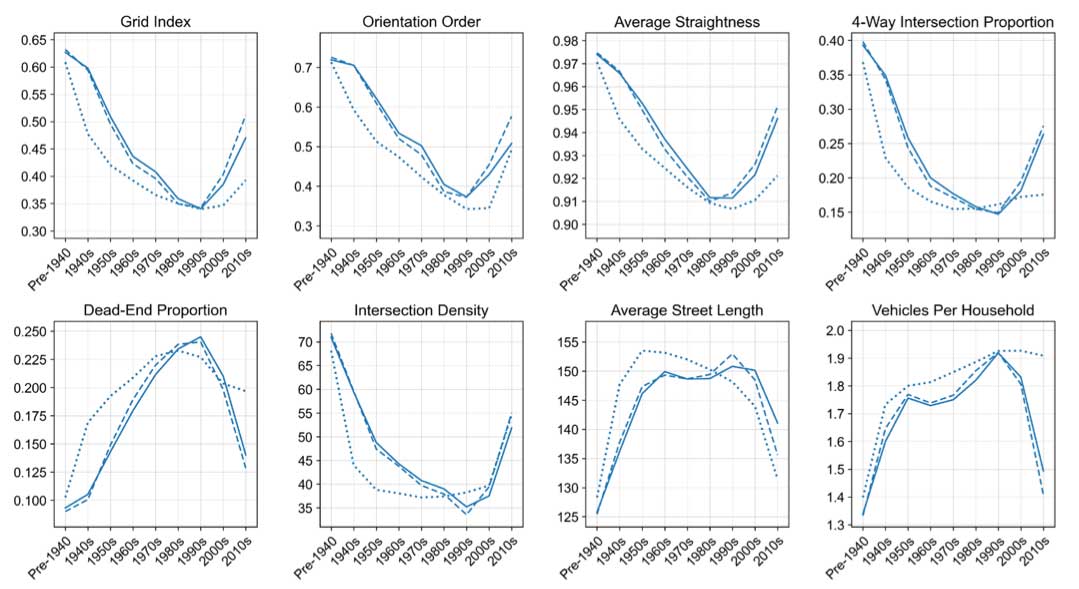
The grid makes a comeback
Since 2000, connected street networks have made a comeback, according to a University of Southern California analysis of US streets over the past century. “Since 2000, the grid index and its components have risen back to levels not seen since the mid-20th Century,” notes Geoff Boeing, assistant professor in the Department of Urban Planning and Spatial Analysis at USC. Boeing’s paper “Off the Grid … and Back Again? The Recent Evolution of American Street Network Planning and Design,” was published in the Journal of the American Planning Association in October.
Higher “griddedness” is associated with less car ownership—which is related to lower vehicle kilometers traveled (VKT) and greenhouse gas emissions, Boeing says. “To successfully implement climate action plans or attenuate pervasive car dependence, practitioners must plan for denser, interconnected networks that allow for non-motorized travel and mass transit provision. This study finds preliminary evidence of some promising trends in this direction toward more sustainable urban forms.”
Street networks last a long time—and so are important for sustainability. “The initial layout of streets and attendant land parcelization determine urban spatial structure for centuries, locking in mobility needs and capabilities for generations to come,” he explains.
Boeing lists three reasons for a return of the grid: 1) New certification standards like LEED-ND; 2) Better-planned redevelopment and retrofit projects of recent years; and 3) A shift in market demand. Here’s a quote from the study:
“… new certification standards like LEED-ND promote neotraditional grid-like street network patterns as instruments of sustainability planning in new communities. But even redevelopment and retrofitting projects offer practitioners important opportunities. For instance, Syracuse, NY is currently planning to tear down its 1950s-era Interstate 81 freeway and restore the original street grid (Scheer, 2020). … A shift back toward traditional network patterns may also reflect market demand for more walkable places. As Handy (2017) points out, while academics continue to home in on relevant explanatory variables and regression elasticities, practicing planners, designers, engineers, and developers have recently proceeded with more-compact development for myriad reasons beyond theoretical VKT reductions.”
The trend is known as New Urbanism, which began with CNU Congresses in the 1990s. New urbanist redevelopment and retrofit designs have also contributed to “griddedness,” which is Boeing’s term for combination of intersection density, lack of dead-ends, straightness of streets, and other characteristics. However, LEED-ND, of which CNU was co-author, has not contributed significantly, in my view. LEED-ND has served as a model for best practices, but its practical impact has been sleight. Form-based codes (FBCs), on the other hand, have been widely adopted, and played a bigger role. Three major redevelopment projects that have restored a connected network of streets in the last two decades—Mueller in Austin, Stapleton in Denver, Baldwin Park in Orlando (former Naval Training Center)—all follow FBCs.
“Griddedness” declined in the 1940s and this trend accelerated in the 1950s and 1960s. Changes to the street network are cumulative. As of 1950 we still had all of the gridded streets built prior to 1940—and some new streets that were still fairly connected. Sprawl became more noticeable in the 1950s as “griddedness” plunged and remained in a steep dive through the 1960s. The postwar building boom was in full throttle in those decades, and the restructuring of the American landscape—and lifestyle—became massively apparent. Street connectivity continued to decline, although not as steeply, through the 1990s.

Above are graphs from the study that clearly show plunging intersection density, straightness, 4-way intersections, and orientation order, and rising dead-ends and average street length from middle to the end of the 20th Century. These trends reversed sharply since 2000.
How planners can act
Boeing calls for planners to establish street networks in a proactive way. “Rather than merely reacting to fleeting mobility trends, it is imperative for practitioners to plan proactively for the dense, interconnected networks that can attenuate car dependence and advance city climate action plans.”
This can be done in four ways, he says: 1) Through suburban retrofit; 2) Through planning of large redevelopment parcels; 3) By laying down grids on greenfield sites; and 4) By locating development on historically gridded infill sites. In general, codes and design guidelines should be reviewed and revised at every level of government to enable sustainable street networks, he says. Strategies 2 and 4 offer the most promise, Boeing believes:
First, individual suburban retrofits can improve connectivity but are limited by the path dependence of infrastructure and land parcelization. Second, larger redevelopment projects offer strategic opportunities to incorporate (or restore) fine-grained, highly-connected circulation networks into their design. Good design can mitigate historical criticisms of the grid’s monotony by providing public space, human-scaled streetscaping, and façade variation. Third, greenfield development may offer practitioners the most straightforward opportunity to continue the aggregate trend back toward more-connected patterns, but such projects are often disconnected from the rest of the urban fabric and far from job centers. Finally, interconnected and relatively fine-grained grids already exist in the cores and inner-ring suburbs of most large US cities. Instead of building new grids on the urban fringe, planners can promote infill and densification where the physical infrastructure already best supports active transportation and freedom of mode choice. Overall, planners and policymakers should review and revise codes and design guidelines at local, state, and federal levels to encourage and streamline the development of networks that support broader sustainability and public health goals.
Existing automobile-oriented thoroughfares and ownership patterns pose great challengers for suburban retrofit. However, dead and dying malls and shopping centers offer substantial opportunity for redevelopment with street grids—and these sites are generally under single ownership. Conventional suburbs comprise 90 percent or more of metro areas, and suburban retrofit seems like the only path to fixing them.
Boeing is somewhat dismissive of greenfield development, but such development is not always on the urban fringe—far from job centers. Undeveloped parcels are often skipped over and may be located near major employers, especially in smaller-to-mid-sized metro areas. Moreover, street layout influences urban patterns for centuries. Who can accurately predict that any site will not be close to a job center in 50 years? Given the long-lasting nature of streets, it is better to establish a sustainable street pattern from the start—even if the site is currently isolated.
The plan for Bastrop, Texas, which won a CNU Charter Award this year, offers a great model for how the public sector can re-establish connected street networks for more sustainable and resilient growth. The image at the top of this article is from the Bastrop plan. It shows designs for blocks—by Simplecity, which worked with Bastrop on the code—that would be part of a street network. The plan allows design decisions for each development that maintain connectivity yet respond to the natural environment and market.
Overall, this study offers surprisingly good news for America’s land-use planning and development. A change in planning philosophy, with leadership from the New Urbanism in conjunction with market trends, made a substantial impact on street networks and development patterns in the last two decades. An outlook favorable to street grids, along with market trends toward walkable communities, are bound to carry forward in the coming decades.
Here's a link to the entire paper: https://osf.io/t9um6




